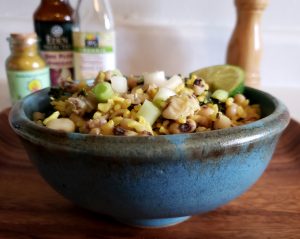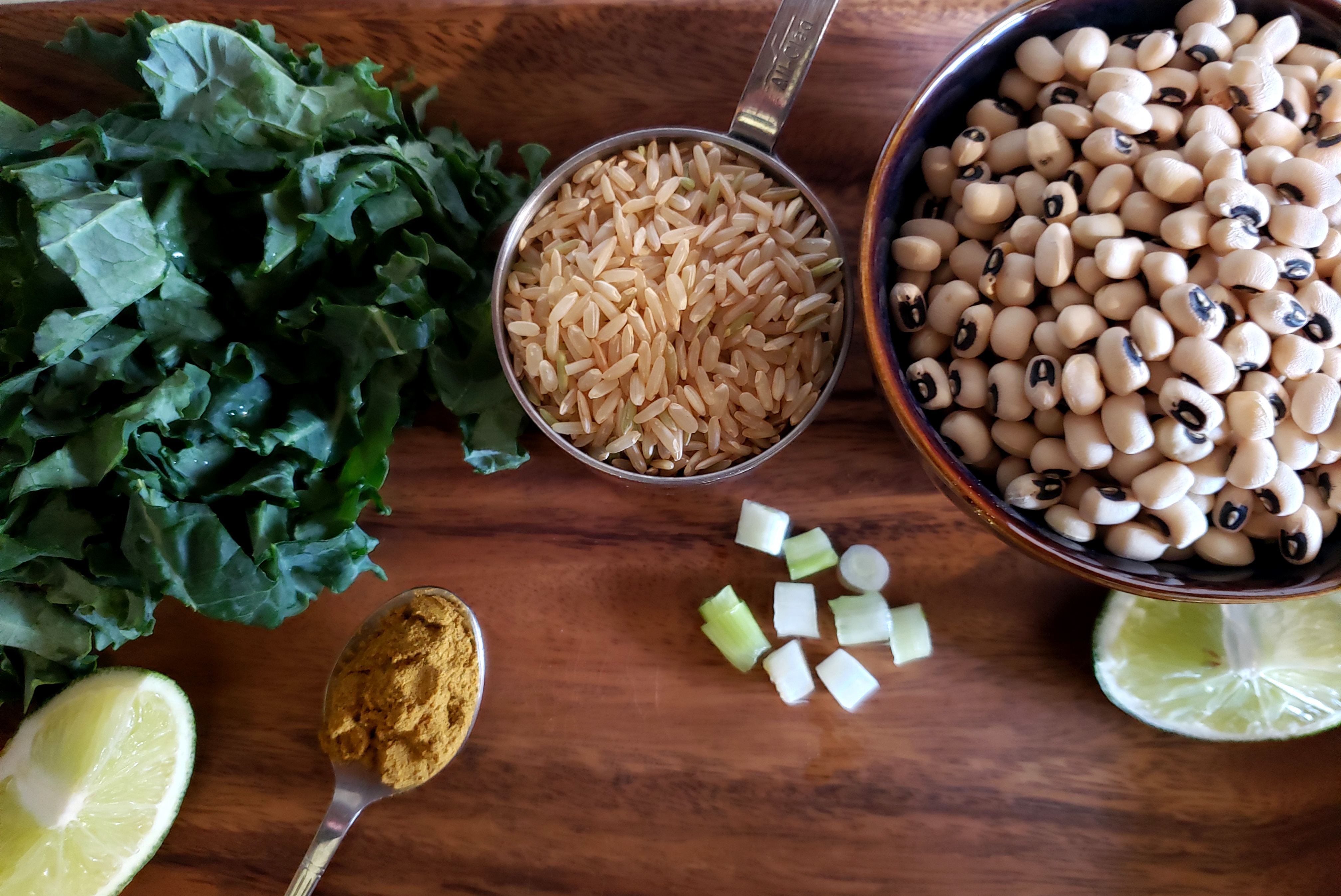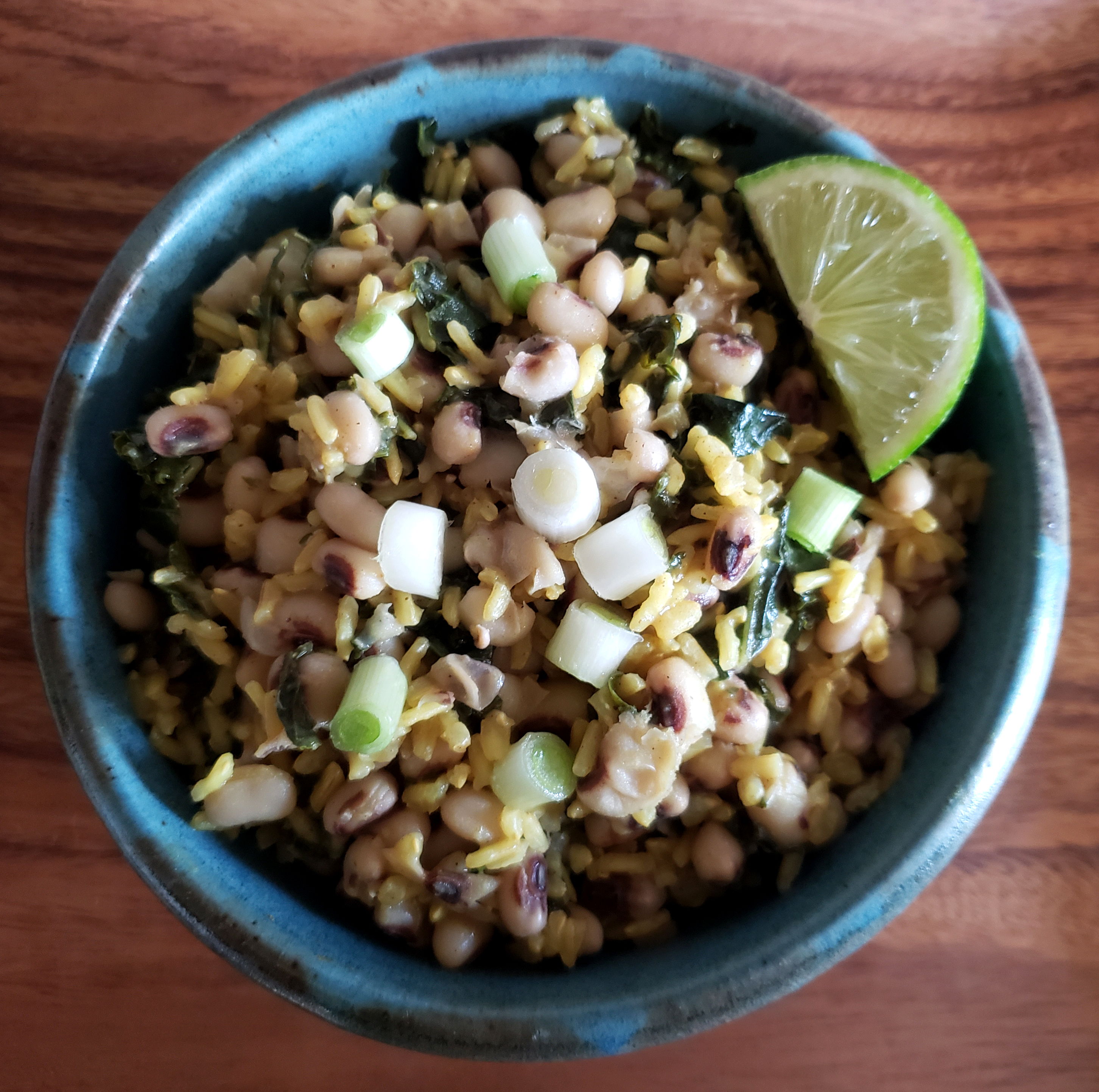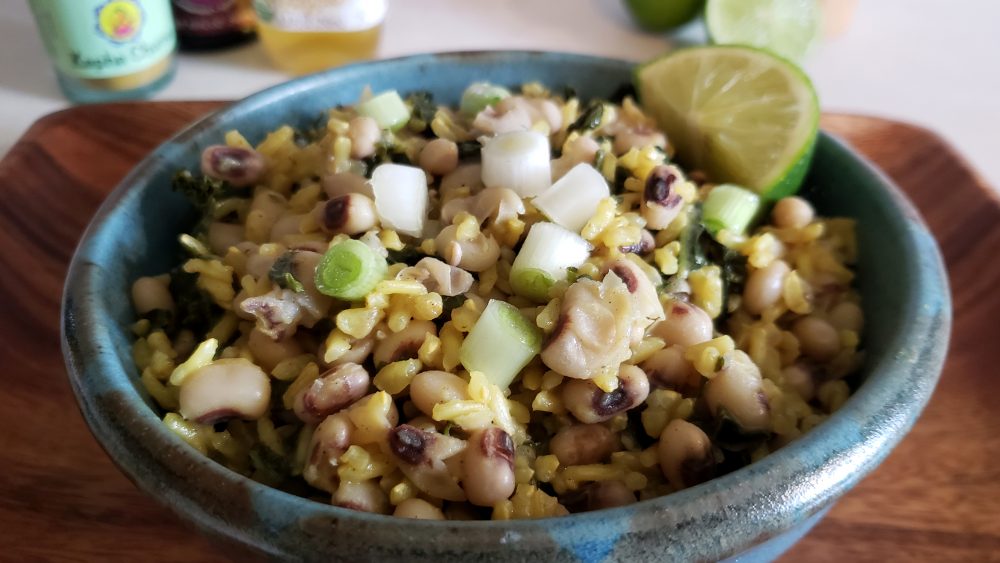 Black eyed peas are an amazing protein-packed addition to any healthy diet as they possess a wide range of plant-based nutrients and consequently a wealth of health benefits. Unfortunately there is not a lot of knowledge out there on how to cook black eyed peas, and sometimes they can be associated with being bland or boring. Therefore I am quite excited to share this Ayurvedic black eyed pea recipe that is healthy, delicious and full of flavor!
Black eyed peas are an amazing protein-packed addition to any healthy diet as they possess a wide range of plant-based nutrients and consequently a wealth of health benefits. Unfortunately there is not a lot of knowledge out there on how to cook black eyed peas, and sometimes they can be associated with being bland or boring. Therefore I am quite excited to share this Ayurvedic black eyed pea recipe that is healthy, delicious and full of flavor!
This recipe is undoubtably packed with vital nutrients that will help heal and prevent disease and disorders of all types (let food be thy medicine!). Black eyed peas are a great for promoting healthy elimination, sustaining the appetite, reducing food cravings, aiding in weight loss, increasing bone health, balancing the blood sugar, lowering cholesterol levels, and lowering the blood pressure. They are great for building the blood due to their high iron content and an excellent choice during pregnancy, postpartum, and breast feeding.
Health Benefits of Black Eyed Peas
- Anti-inflammatory, regular intake helps reduce chronic inflammation
- Improves healthy elimination and colon health
- Treats and prevents anemia
- High in fiber (44% DV per 1 cup of cooked beans)
- High in iron (20% DV per 1 cup of cooked beans)
- Great plant-based protein source (14g per 1 cup of cooked beans)
- High in B vitamins including folate and thiamin
- High in vitamin A
- Good source of essential minerals such as magnesium, calcium, phosphorus, potassium, and sodium
- Low on the glycemic index
- Prevents sugar cravings and mood swings
- Aids in weight loss
- Lowers your risk for diabetes
- Great dietary staple during pregnancy, pre-pregnancy and postpartum
- Promotes skin, eye and hair health
- Promotes overall heart health
- Lowers blood pressure and cholesterol levels
- Strengthens bones, prevents osteoporosis and fractures
Although black eyed peas will provide you with an array of nutrients, this recipe also includes some other healthy dietary staples such as brown rice and kale. The Ayurvedic spices and healthy fats that are included are essential for promoting healthy digestion, warding off potential gas formation, and provide multiple healing properties all of their own.
Black Eyed Peas and Kale Rice Bowl Recipe
Click here for a printable copy of this recipe.
- Doshic effect: Vata ↑*, Pitta ↓, Kapha ↓
- Serves: 2
- Prep Time: 10 minutes
- Cook Time: 60 minutes
- Vegan, Vegetarian
- Gluten-Free
*See the optional doshic variations below the recipe to make it more Vata-friendly!
Materials
- Large sauce pan
- Medium sauce pan
- Cutting board and knife

Ingredients
- 6 cups water, for cooking the beans
- 2 1/2 cups chicken, bone, or veggie broth (substitute with water), for cooking the rice
- 1 cup black eyed peas, soaked overnight
- 1 cup brown rice
- 2 to 3 large kale leaves, stemmed and thinly sliced
- 1/3 cup minced onion
- 1/4 teaspoon cumin seeds, whole
- 1/4 teaspoon brown mustard seeds, whole
- 1 to 2 teaspoon Kapha Churna (substitute with 1/2 teaspoon of turmeric)
- Fresh ginger (1 inch cube), finely grated
- Large pinch cayenne pepper (optional)
- 2 tablespoons sesame oil, divided
- 1 lime, juiced
- 1 teaspoon of ume plum vinegar (optional but recommended)
- 1/4 teaspoon of pink Himalayan salt (and extra to taste)
- Freshly ground black pepper to taste

Click here for a printable copy of this recipe.
Directions
Cooking the black eyed peas:
1. Soak the black eyed peas overnight making sure to allow at least three inches of extra water to cover the beans.
NOTE: If a speed soaking is needed, boil water and cover the dry beans for a minimum of 1 hour prior to cooking.
2. After the soaking process is complete, strain the beans and discard the water.
3. Place 6 cups of water into a large sauce pan. Bring this to a boil and then add the beans.
4. Reduce the heat to low-medium and cook covered (leaving a small crack) for 50 to 60 minutes.
5. As the beans are cooking, prepare the brown rice and kale (see below).
6. At 50 minutes check on the beans. The finished bean should be soft to touch and the skins will begin to come off of the bean. If more time is needed, continue cooking until the desired texture is reached, checking every 5 minutes or so.
7. Once they are fully cooked, strain the beans and discard the water. Place the strained beans back into the pan and cover until they are ready to be added to the rice.
Cooking the brown rice and kale:
1. Place a medium sauce pan over medium heat and add in 1 tablespoon of sesame oil. Once hot, add in the onion, cumin, and brown mustard seeds and sauté here for 2 minutes (or until they start to crackle) stirring frequently to avoid burning the spices. Add in the Kapha Churna and cayenne pepper (if used) and continue to sauté for an additional 30 to 60 seconds stirring constantly.
2. Add in 2 1/2 cups of broth into the pan. Bring the broth and sautéed spice mixture to a boil and then add in the brown rice and 1/4 teaspoon of Himalayan salt, reducing the heat to low.
3. Cook, mostly covered, over low heat for 25 minutes.
4. After this amount of time, place the thinly sliced kale on top of the half cooked brown rice and cover the pan completely. Cook here for an additional 15 minutes.
IMPORTANT NOTE: Do NOT stir the kale with the rice, but rather leave it to steam cook over the top of the rice. Mixing the rice with the kale at this point will cause some of the rice to not cook all the way.
5. Once the 15 minutes have passed, stir the kale and rice together.
6. Turn off the heat, but leave the pan covered and on the hot burner. Leave here for an additional 10 minutes to allow the rice to soak up any leftover broth and continue to soften.
Final Steps:
1. Add the cooked brown rice and kale to the cooked black eyed peas. Stir them together so they are evenly tossed.
2. Add in the freshly grated ginger, lime juice, 1 tablespoon of sesame oil, Ume Plum Vinegar, salt, and pepper to taste. Stir well until the seasonings are all blended evenly.
3. Serve in your favorite bowl and garnish with a handful of chopped green onions. Stir in more lime juice, salt, or pepper if needed.
4. Sit, share, and enjoy in good company!

Optional Doshic Variations
Vata:
Black eyed peas and kale tend to be Vata-provoking due to their light and airy nature. To make this recipe more suitable for Vata types, allow proper soaking time for the beans, soaking them overnight rather than using the speed method. Cook the beans for an additional 15 to 30 minutes to make them easier to digest. The brown rice and kale should be cooked slightly longer and more broth can be added as needed during the extra cooking time. The brown rice should be very soft and slightly liquidy after the cooking process is complete. The amount of sesame oil should be doubled both when adding it to the sauté and when adding it during the final steps. If available, Vata Churna can be used in place of Kapha Churna and extra spices can be used all around.
If these recommendations are followed and the recipe still produces gas, bloating or any other unwanted Vata symptoms, then this recipe should be avoided until the digestive fire is strengthened and Vata has come back into balance.
Pitta:
This recipe is overall Pitta-reducing, although a few changes can be made to minimize the heat of certain ingredients. The cayenne pepper should be omitted and the sesame oil should be replaced with equal amounts of coconut oil. The ume plum vinegar should be omitted, and extra pink Himalayan salt can be added as needed. Pitta Churna can be used in place of the Kapha Churna and freshly chopped cilantro leaves can be added as a cooling garnish (add at the same time as the green onions).
Kapha:
The dry, light and airy nature of the black eyed peas make this recipe a healthy, lean, protein-packed meal for Kapha types to enjoy regularly. It is beneficial for times of excessive weight issues, congestion, sluggish digestion, and slow metabolism. To promote the Kapha-reducing benefits even further one can replace 1/2 cup of the uncooked brown rice with 1/2 cup of the uncooked black eyed peas (adjust the amount of broth as needed for the rice). Alternatively 1/2 cup of the brown rice can be replaced with extra kale or other bitter greens. The amount of sesame oil can be cut in half and the salt should be used moderately. All of the spices here are Kapha-reducing and can be used generously to enhance the digestion and metabolism even further.


